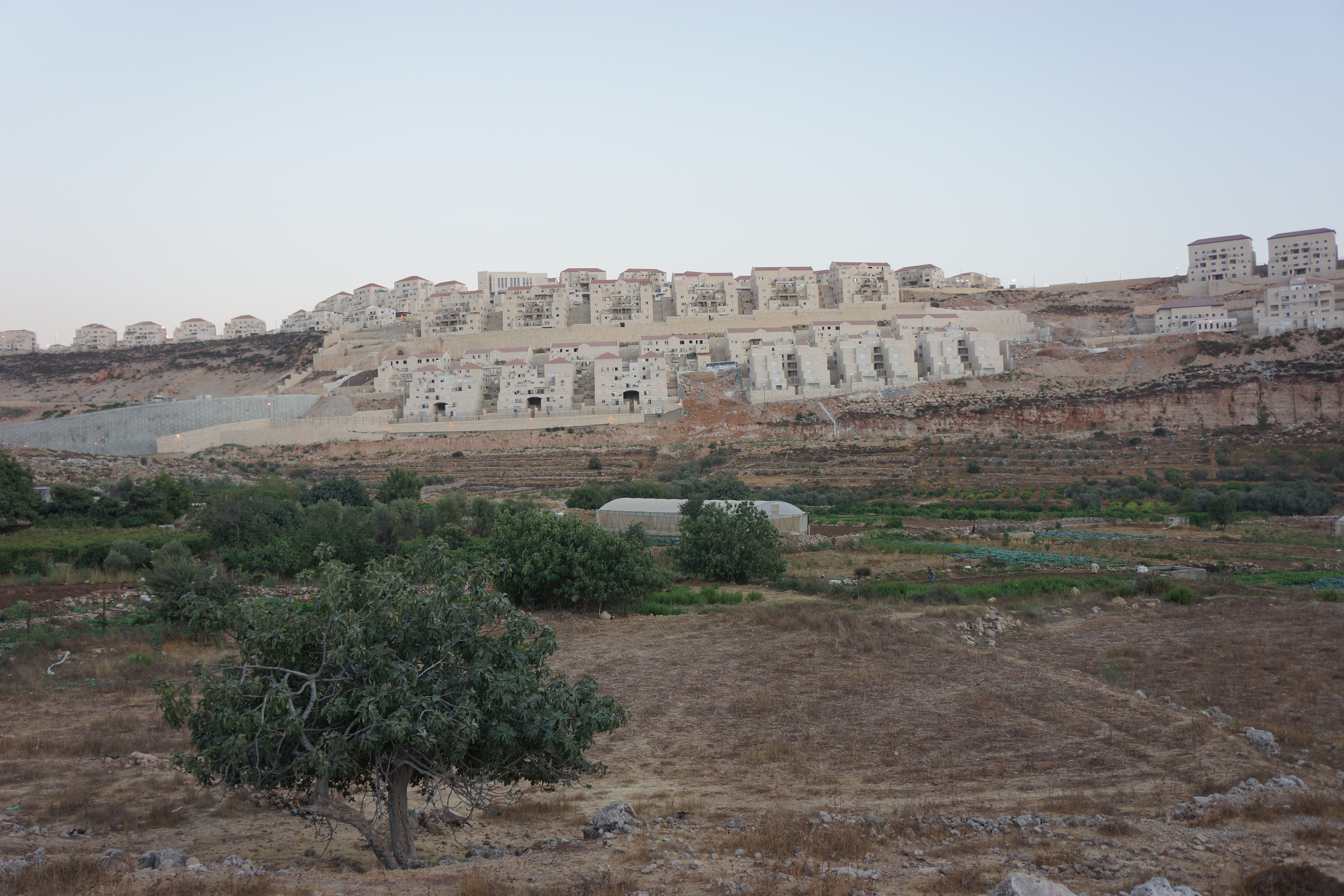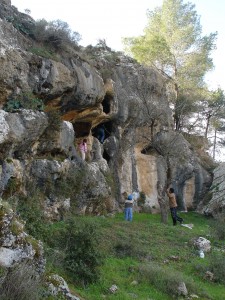Hiking the West Bank

In his award-winning 2008 memoir, Palestinian Walks, Palestinian lawyer and human rights activist Raja Shehadeh reflected on 25 years of hiking through the “vanishing landscape” of the West Bank: “As I stood in the ruins of one of my favorite places in the valley, this valley near where I was born and have always lived, I felt the hills were not mine any more. I am no longer free to come and walk.” The hills, valleys, and fields of Palestinian villages are now the front lines of the struggle over Israeli colonization of the West Bank. Hiking has become an act of resistance.
For generations, trails have connected Palestinian villages and cities. Farmers use these trails to bring produce to regional markets; shepherds and Bedouins follow herds through the hills; well-worn paths enable visits to friends and relatives in neighboring villages. During the nakba (catastrophe) in 1948, hundreds of thousands of Palestinians walked these trails as they fled their villages. And after Israel occupied the West Bank and Gaza Strip, Palestinians formed hiking groups to encourage familiarity with the land and “voluntary work committees” to build ties among cities, villages, and refugee camps.The Israeli occupation has transformed the landscape of the West Bank through the widespread confiscation of Palestinian land, the continual expansion of Israeli settlements, the construction of a network of settler highways, the proliferation of military checkpoints, the erection of an enormous separation wall, and the enforcement of military restrictions on Palestinian movement. Since the beginning of the Oslo “peace process” in the early 1990s, Israeli domination has deprived Palestinian communities of not only land but also connections. It has fragmented Palestinian society and isolated the villages.
The hills west of Bethlehem, for instance, are home to nine Palestinian villages. Thirteen Israeli settlements have been built on the land of these villages, separating them from one another as well as from Bethlehem and nearby Jerusalem. On a weekly basis, Israeli authorities confiscate small plots of land and prevent the villagers from working in their fields. In addition, the villagers confront daily forms of encroachment by Jewish settlers, who release sewage into cultivated fields, destroy olive trees and grape vines, expropriate property, and attack farmers trying to reach their own lands.
These settlements make up the Gush Etzion block, which Israeli officials insist will eventually be annexed to Israel. Four days after the ceasefire that brought an end to Israel’s 2014 attack on Gaza, the Israeli government announced the confiscation of 1,000 acres of land from four Palestinian villages for the expansion of these settlements.In the face of intense pressure, Palestinians have developed numerous tactics to remain on their land, including court cases and collective mobilizations. Above all, they practice a culture of resistance known as sumoud (steadfastness)—a resilient will to remain present rather than succumb to dispossession and displacement. The village of Al-Araqib, for instance, has been demolished dozens of times since 2010 as the Israeli government tries to relocate Bedouin villages in the Naqab (Negev) desert. Each time it is demolished, Palestinians rebuild.
Similarly, millions of Palestinian refugees have remained in refugee camps in the occupied territories and neighboring countries for 65 years rather than give up on the goal of returning to their lands.
In the western villages of Bethlehem, farmers continue defiantly planting vegetables despite Israeli restrictions on access to land, water, and markets. A 70-year-old man explained, “I don’t make any money from my vegetables. But I continue to farm in order to defend the land.” Although the Palestinian Authority (PA) has little jurisdiction in the villages, a handful of non-governmental organizations encourage sumoud by helping farmers rehabilitate land, plant trees, dig wells, and pave roads. “The primary form of resistance is land improvement. We have no other source of strength,” said an organizer. In response, Israeli military authorities routinely issue orders to destroy new wells, tear up new roads, or return freshly terraced land to its previous condition.

In recent years, Palestinians have reasserted their presence in the hills and valleys of the West Bank through a revival of hiking. Some villages have rehabilitated old trails and built new ones. In Battir, for instance, Palestinians have cleaned up old trails to Beit Jala and Bethlehem, placed trail markers and rest stops along the route, and built a guesthouse and an ecomuseum in the village.
In addition, organizations such as the Siraj Center promote hiking as a form of alternative or solidarity tourism. Hikers not only experience the dramatic beauty of the Palestinian landscape, they also visit sites of historical and religious significance, witness the occupation, and meet Palestinian families in villages along the trails. Local bookstores even sell a newly published guidebook to hiking trails in the West Bank (Walking Palestine: 25 Journeys into the West Bank).
And, for the first time in decades, Palestinian residents of cities and refugee camps have begun taking hikes through nearby villages. In the wake of the 2nd intifada (uprising, from 2000-2005), Israel eased restrictions on Palestinian movement when the PA agreed to resume coordinated security operations. Alongside a growing number of hiking clubs, many Palestinians now go out as families or in small groups to visit friends, nearby springs, desert monasteries, or the tombs of local saints. Their hikes establish a Palestinian presence in contested territories, including sites identified as locations for future settlements. They also deepen popular knowledge of the land. A farmer from Al-Khader village, for instance, takes photographs during his walks of endangered plants that are no longer being cultivated.
Many hope that hiking can challenge the isolation of the villages and the fragmentation of the Palestinian population. An organizer in the Palestinian Farmers Union told me, “We have a monthly tour in a picnic style to see a lot of areas and villages. Maybe people volunteer, maybe they don’t. But at least they come to know the places and one another. It is much like the voluntary work committees in the 1980s. They created connections so that when organizers went in to advocate, people knew each other and they worked together.”Hiking is also deeply rooted in Jewish Israeli culture, encouraged by religious, military, and political authorities. Israeli guidebooks advertise thousands of kilometers of hiking trails, many of which traverse the West Bank. Armed Israelis regularly venture into Palestinian villages on hikes to ancient Jewish landmarks and other sites of interest.
Villagers in Wadi Fukin, for instance, regularly encounter groups of settlers picnicking on their lands and swimming in the pools that feed their fields. A village leader described a recent encounter: “They were sitting in a farmer’s hut. We didn’t see how many, but there were groups of them and they were armed of course. When they saw us, they went in and got their guns and stopped us. We were walking towards them and they said, ‘Stop. Where do you want to go? Give me your ID.’ We said, ‘How are you asking me where I want to go? We’re going to our land. What are YOU doing here?’” As often occurs during such confrontations, Israeli soldiers were called in to diffuse tensions and ensure the safety of the trespassing settlers.
I had a similar encounter in 2013 when I accompanied two friends from Dheisheh refugee camp in Bethlehem on a visit to a spring in Al-Walaja village. It was the first time they had visited the area in more than 20 years. Enjoyment turned to anxiety when we arrived to find armed Israelis sitting by the beautiful pool. Feeling uncomfortable in their presence, we soon left. But two Palestinian boys from a nearby village remained undaunted. They swam in the pool, played in the springs, and refused to leave on account of the Israelis.As Israel continues its steady colonization of the West Bank, Palestinian communities become smaller, more isolated, and more fragmented. The recent revival of hiking emerges from and contributes to the everyday culture of steadfastness, sumoud. Yet hiking is not necessarily a conscious political act—it is often simply a form of relaxation, exercise, meditation, or escape. Nevertheless, hiking in the West Bank must be understood within the context of resisting the occupation.
As Shehadeh reflects, “How unaware many trekkers around the world are of what a luxury it is to be able to walk in the land they love without anger, fear, or insecurity, just to be able to walk without political arguments running obsessively through their heads, without the fear of losing what they’ve come to love, without the anxiety that they will be deprived of the right to enjoy it. Simply to walk and savour what nature has to offer, as I was once able to do.”

Comments 3
Jack Decoteau
June 4, 2015Mr. Clarno is a great writer and his understanding of the Palestinian plight is excellently understood and exemplified in this article. Well done Mr. Clarno
Laurie Schaffner
June 5, 2015Dr. Clarno consistently produces cutting edge work documenting and clarifying the events and issues surrounding ongoing struggles among Palestinians and Israelis. As an US Jewish feminist who supports peace and independence for Palestine, I continually rely on Dr. Clarno's incisive, critical, and heart-full analyses.
Alex
July 3, 2015Andy Clarno's brilliant work, including his important academic work has a way of bringing to life distance realities you hear about mostly in the media. His focus on liminal zones (Johannesburg, Israel/Palestine) - which we know are places with much injustice - is inspiring.